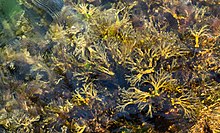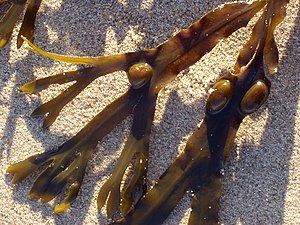| Fucus vesiculosus | |
|---|---|

| |
| Scientific classification | |
| Domain: | Eukaryota |
| Clade: | Diaphoretickes |
| Clade: | SAR |
| Clade: | Stramenopiles |
| Phylum: | Gyrista |
| Subphylum: | Ochrophytina |
| Class: | Phaeophyceae |
| Order: | Fucales |
| Family: | Fucaceae |
| Genus: | Fucus |
| Species: | F. vesiculosus
|
| Binomial name | |
| Fucus vesiculosus | |

Fucus vesiculosus, known by the common names bladderwrack, black tang, rockweed, sea grapes, bladder fucus, sea oak, cut weed, dyers fucus, red fucus and rock wrack, is a seaweed found on the coasts of the North Sea, the western Baltic Sea and the Atlantic and Pacific Oceans. It was the original source of iodine, discovered in 1811, and was used extensively to treat goitre, a swelling of the thyroid gland related to iodine deficiency.[1]
- ^ "Bladderwrack". WebMD. Retrieved 27 September 2018.